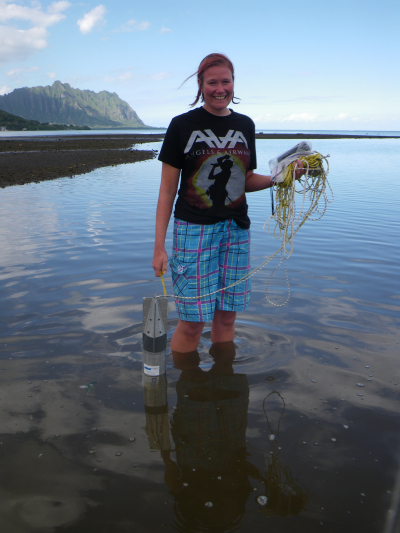Die Inhalte dieser Seite sind leider nicht auf Deutsch verfügbar.
Seitenpfad:
Nina Stark
Report of GLOMAR PhD student Nina Stark about her research stay at the University of Hawaii at Manoa in Honolulu from 6 December 2008 - 23 January 2009
From December 2008 until the end of January 2009 I had the possibility to work at the School of Ocean and Earth Sciences and Technologies (SOEST, http://www.soest.hawaii.edu/) at the University of Hawaii at Manoa supervised and supported by Roy Wilkens (Director of the National Center for Island, Maritime and Extreme Environment Security). We had planned side-scan surveys and geotechnical measurements of the Halekulani Sand Channel in front of Waikiki in situ as well as in the laboratory. The Halekulani Sand Channel is surrounded by a sensible reef system and, though, is used for dredging the sand to conserve Waikiki beach. For the side-scan surveys we planned to deploy REMUS, an autonomous side-scan system provided by Roy Wilkens and Geno Pawlak and for the geotechnical measurements I brought NIMROD, our small free-falling penetrometer. Furthermore, we took box corer samples. Geotechnical laboratory facilities were provided by Horst Brandes at the Department of Engineering.
In the first weeks we had to abort measurements twice because of too high waves in the area close to Waikiki and flash flood warnings at the South Shore. After bettering of the weather conditions and a change from southern Kona storms to eastern trade winds we succeeded deploying NIMROD about forty times, taking about ten sediment samples and running two REMUS missions along the about one mile long Halekulani Sand Channel. The measurements benefited enormously by the support of Jennifer Dussault, Sergio Jaramillo, Nils Hoever, Nancy Niklis and Timothy Roy.
After finishing these measurements Charles Bachmann (Naval Research Laboratory, Washington D.C., Head, Coastal Sciences and Interpretation Section) asked for support of their HI-HARES project at the Windward Side of O’ahu by NIMROD deployments. Facing the problem that on the remaining days of my stay no boat was available we decided to deploy NIMROD, which is designed for measurements from small boats and in difficult areas, for the first time from a one-seat kayak. Supported by Roy Wilkens and Nils Hoever it succeeded to make about 90 deployments in Waimanalo Bay, Kailua Bay and Kaneohe Bay.
Our measurements seem to provide data for publications about a comparison of quartz sand to the Hawaiian coral sand, the Halekulani Sand Channel and its development of bearing capacity with depth and about the geotechnical differences of the sea floor in the three Windward Side Bays at Waimanalo, Kailua and Kaneohe. Beside that I had the chance to meet very interesting and welcoming people. My horizons were widened by talking to them and working together. This research stay was doubtless an important part of my PhD project and my scientific development. I thank GLOMAR a lot for the funding!
In the first weeks we had to abort measurements twice because of too high waves in the area close to Waikiki and flash flood warnings at the South Shore. After bettering of the weather conditions and a change from southern Kona storms to eastern trade winds we succeeded deploying NIMROD about forty times, taking about ten sediment samples and running two REMUS missions along the about one mile long Halekulani Sand Channel. The measurements benefited enormously by the support of Jennifer Dussault, Sergio Jaramillo, Nils Hoever, Nancy Niklis and Timothy Roy.
After finishing these measurements Charles Bachmann (Naval Research Laboratory, Washington D.C., Head, Coastal Sciences and Interpretation Section) asked for support of their HI-HARES project at the Windward Side of O’ahu by NIMROD deployments. Facing the problem that on the remaining days of my stay no boat was available we decided to deploy NIMROD, which is designed for measurements from small boats and in difficult areas, for the first time from a one-seat kayak. Supported by Roy Wilkens and Nils Hoever it succeeded to make about 90 deployments in Waimanalo Bay, Kailua Bay and Kaneohe Bay.
Our measurements seem to provide data for publications about a comparison of quartz sand to the Hawaiian coral sand, the Halekulani Sand Channel and its development of bearing capacity with depth and about the geotechnical differences of the sea floor in the three Windward Side Bays at Waimanalo, Kailua and Kaneohe. Beside that I had the chance to meet very interesting and welcoming people. My horizons were widened by talking to them and working together. This research stay was doubtless an important part of my PhD project and my scientific development. I thank GLOMAR a lot for the funding!



